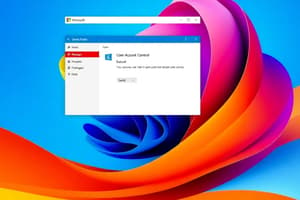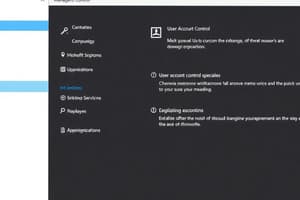Podcast
Questions and Answers
What is User Account Control (UAC)?
What is User Account Control (UAC)?
User Account Control (UAC) is a feature introduced in Windows Vista that helps minimize the dangers of unwanted actions or unintended software installations.
What is a standard user account?
What is a standard user account?
A standard user account has the least amount of user rights and privileges required to perform most basic tasks.
How do you turn off and customize UAC?
How do you turn off and customize UAC?
You can go to User Accounts in the Control Panel, or in Windows 7, go to System and Security in the Control Panel and use the link under the Action Center.
If you disable UAC, the system prompts when changes require administrative privileges.
If you disable UAC, the system prompts when changes require administrative privileges.
Signup and view all the answers
What must you do after enabling or disabling UAC?
What must you do after enabling or disabling UAC?
Signup and view all the answers
What does Remote Desktop allow you to do?
What does Remote Desktop allow you to do?
Signup and view all the answers
What can you configure when making a Remote Desktop connection?
What can you configure when making a Remote Desktop connection?
Signup and view all the answers
What port does Telnet use?
What port does Telnet use?
Signup and view all the answers
What port does SSH use?
What port does SSH use?
Signup and view all the answers
What port does Remote Assistance use?
What port does Remote Assistance use?
Signup and view all the answers
What does application installation typically involve?
What does application installation typically involve?
Signup and view all the answers
Study Notes
User Account Control (UAC)
- User Account Control (UAC) is a security feature introduced in Windows Vista and included in Windows 7, designed to minimize risks from unauthorized actions or software installations.
- UAC prompts users for permission before making changes that could affect system security or performance.
Standard User Account
- A standard user account has minimal rights and privileges necessary for basic operations.
- Administrator accounts can perform any action on the system, including critical tasks that standard users cannot.
Customizing UAC
- To customize UAC settings, access User Accounts through the Control Panel; in Windows 7, it can also be adjusted via System and Security settings.
- For Windows Vista, UAC can be toggled in the Control Panel directly.
Consequences of Disabling UAC
- Disabling UAC or setting it to "Never notify" removes prompts for administrative changes, increasing vulnerability to security threats.
- Programs executed without UAC prompts gain the same level of access as the user, which can be risky.
Restart Requirement for UAC Changes
- Changes to UAC settings require a computer restart to take effect; however, some adjustments, like changing prompt behavior, do not need a restart.
Remote Desktop Overview
- Remote Desktop allows remote access to a computer; the server remains operational to accept connections.
- Host systems must be running Windows XP or higher, and Remote Desktop is available on specific versions (Professional, Business, Enterprise, Ultimate).
- Client machines need compatible software, which is included with Windows XP and later versions, while earlier versions require separate installation.
Remote Desktop Connection Features
- Users can redirect devices such as sound and printers from the client to the remote host, allowing seamless usage of local resources.
- Local drives can be mapped to the remote session for easier file transfers between the two machines.
Telnet Port Usage
- Telnet operates over TCP port 23, offering a plain-text, unsecured method for remote console connections.
SSH Port Usage
- Secure Shell (SSH) provides encrypted remote access, offering similar functionality to Telnet while maintaining data confidentiality.
Remote Assistance Port
- Remote Assistance connections require firewall configuration to allow traffic through port number 3389.
Application Management Insights
- Application installation involves more than file copying; it modifies system registry, creates shortcuts, and sets application-specific configurations.
- Shortcuts created during installation provide quick access to applications and can be set for individual or all-user access.
- Shortcuts that reference removable or network drives may become invalid if the drives are disconnected.
Studying That Suits You
Use AI to generate personalized quizzes and flashcards to suit your learning preferences.
Description
Test your knowledge on User Account Control (UAC) with these flashcards. Learn about its features and user account types within Windows Vista and Windows 7. Perfect for those seeking to understand computer security enhancements.




